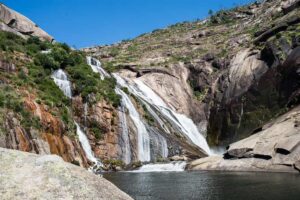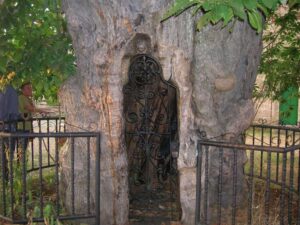The Camino de Santiago is much more than a pilgrimage route; it is a melting pot of cultures, an ancient path that has witnessed countless stories and is a legacy of incalculable historical and artistic value. Recognised by UNESCO as a World Heritage Site, it offers a unique experience where spirituality intertwines with monumental and scenic richness.
In this article, we will explore the main UNESCO World Heritage Sites along the different Jacobean routes, with particular focus on those landmarks pilgrims can admire without deviating from their path.
Índice de contenidos
- 1 The Camino de Santiago: A Living Heritage
- 2 The French Way: The Route par Excellence and its UNESCO Treasures
- 2.1 Royal Collegiate Church of Santa María (Roncesvalles – Navarre)
- 2.2 Church of Santa María de Eunate (Muruzábal – Navarre)
- 2.3 Catedral de Santa María (Pamplona – Navarre)
- 2.4 The Bridge over the Arga River (Puente la Reina – Navarre)
- 2.5 Church of San Pedro de la Rúa (Estella – Navarre)
- 2.6 Monastery of Iratxe / Irache (Ayegui – Navarre)
- 3 Delving into the Heritage of the French Way
- 4 The Northern Routes of Spain: A Diverse Heritage
- 5 Other Caminos and Their Link to UNESCO Heritage
- 6 The Importance of UNESCO Heritage for the Pilgrim
- 7 The Camino as a European Cultural Itinerary: A Melting Pot of Exchange
The Camino de Santiago: A Living Heritage
The Camino de Santiago’s designation as a World Heritage Site by UNESCO is no accident.
In 1993, the French Way was the first to receive this prestigious recognition, followed in 2015 by the Northern Routes of Spain. This distinction highlights the outstanding universal value of these routes for their historical and architectural significance, as well as their role as a motor of cultural and spiritual exchange over the centuries.
UNESCO considers it a cultural itinerary that has shaped the history and art of Europe, a “journey of the spirit” that remains alive and continues to transform those who walk it.
The French Way: The Route par Excellence and its UNESCO Treasures
Undoubtedly, the ultimate Jacobean route. Moreover, it is a true open-air museum, filled with monuments and landmarks that have witnessed centuries of pilgrimage. Every step along this path is a journey through history, art, and spirituality.
Below, we highlight some of the most significant UNESCO World Heritage Sites that pilgrims will encounter along the French Way.
Royal Collegiate Church of Santa María (Roncesvalles – Navarre)
In the village of Roncesvalles, a starting point for many pilgrims, stands the Royal Collegiate Church of Santa María, built between the 12th and 13th centuries. This historic-artistic complex is a magnificent example of early Gothic. Its cloister houses the chapel of San Agustín, where the remains of King Sancho VII the Strong of Navarre rest.
The collegiate church is not just an architectural landmark. It has also been a place of welcome and spirituality, serving pilgrims since its inception by offering shelter and solace after crossing the Pyrenees.
Church of Santa María de Eunate (Muruzábal – Navarre)
Although it is not directly on the main French Way route, the Church of Santa María de Eunate is a Romanesque gem worth a small detour. In fact, it is located on a variant that connects the Aragonese Way with the French Way.
Its unique octagonal shape and the beautiful porticoed gallery with 33 arches surrounding it make it an enigmatic and fascinating building. It is believed to have been built by the Templars or the Order of Saint John, serving as a funeral church and pilgrim hospital.
Catedral de Santa María (Pamplona – Navarre)
In Pamplona, the Catedral de Santa María, with its imposing Neoclassical facade, hides a beautiful Gothic interior. Here lies the mausoleum of King Charles III and Eleanor of Trastámara. However, the real gem is its cloister, considered one of the most beautiful in Europe, with its two impressive doors and the Barbazana Chapel.
The cathedral has been a reference point for pilgrims since the Middle Ages, providing a space for reflection and artistic admiration before continuing their journey.
The Bridge over the Arga River (Puente la Reina – Navarre)
This impressive Romanesque bridge, built in the 11th century, is the symbol of Puente la Reina and one of the most iconic structures along this route. With six of its seven arches visible (one is underground), it has been crucial for both pilgrims and the local economy since the Middle Ages.
Church of San Pedro de la Rúa (Estella – Navarre)
In Estella, the Church of San Pedro de la Rúa stands out. Built from the 12th century, it is considered one of the richest sculptural ensembles of Romanesque Navarre. Despite the renovations it has undergone, it still preserves original elements such as the north and west galleries and its impressive portico.
Monastery of Iratxe / Irache (Ayegui – Navarre)
The Monastery of Iratxe in Ayegui is another key site along the French Way. Founded in the 10th century, it was one of the most important pilgrim hospitals of the Middle Ages, becoming one of the most influential abbeys on the Iberian Peninsula. Its architectural ensemble blends various styles, from Romanesque to Baroque.
Notable features include its Romanesque church, its Plateresque cloister, and its famous wine fountain, which once offered wine to pilgrims.
Delving into the Heritage of the French Way
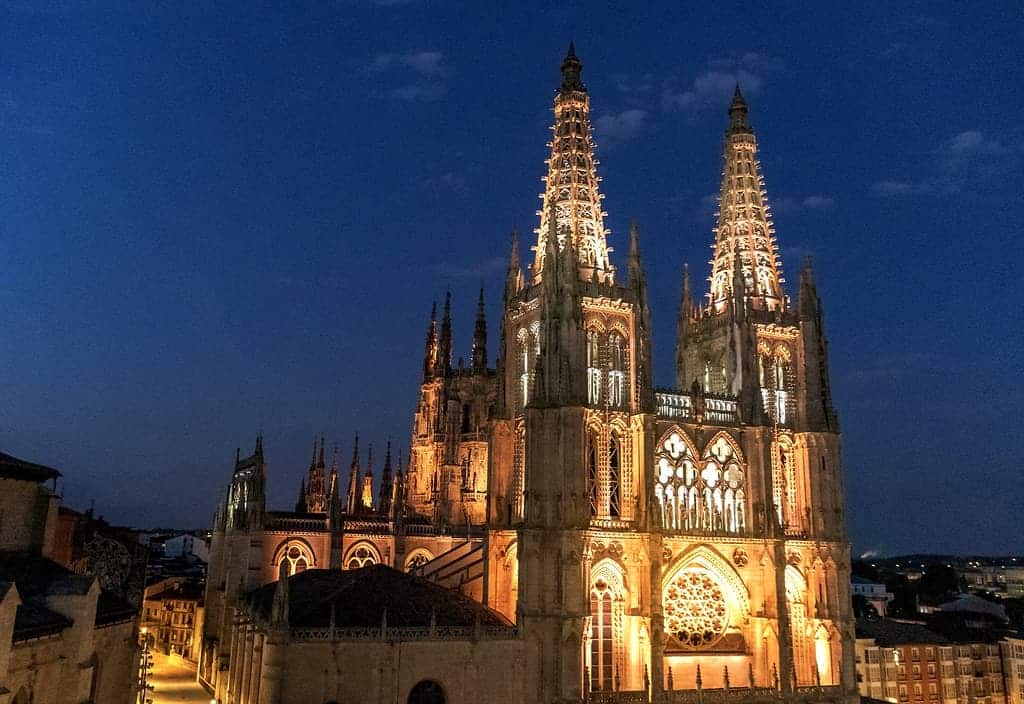
The French Way, with its rich history and constant flow of pilgrims over the centuries, is home to countless cultural assets recognised by UNESCO. Beyond the sites already mentioned, other landmarks dot the route, offering pilgrims the opportunity to connect with the past and admire the craftsmanship of the builders of old.
- The Catedral de Burgos is a must-see. Although the city itself isnot fully listed as a World Heritage Site on the Camino, its cathedral has been individually listed since 1984. This Gothic masterpiece, with its impressive spires and sculptural decoration, is a testament to Burgos’ importance on the Jacobean route.
- The Church of San Martín de Frómista in Palencia. This 11th-century Romanesque temple is one of the purest and most harmonious examples of this style. Its four cylindrical towers, semicircular apse, and rich iconography on the corbels and capitals make it an architectural gem.
- The Catedral de León is another major landmark along the French Way. Known as the “Pulchra Leonina“, this Gothic cathedral is famous for its stunning stained-glass windows, which flood the interior with light and colour. Built from the 13th century, it is a sublime example of classical French Gothic and a symbol of León’s importance on the Jacobean route.
- Nearby is the Monastery of San Miguel de Escalada. This 10th-century Mozarabic monastery is a unique architectural gem on the French Way. Its horseshoe arches, capitals, and Islamic-influenced decoration are a testament to the coexistence of cultures in the Iberian Peninsula during the Middle Ages.
Although it requires a small detour, the visit rewards pilgrims with the chance to contemplate exceptional and rare heritage along the Jacobean route.
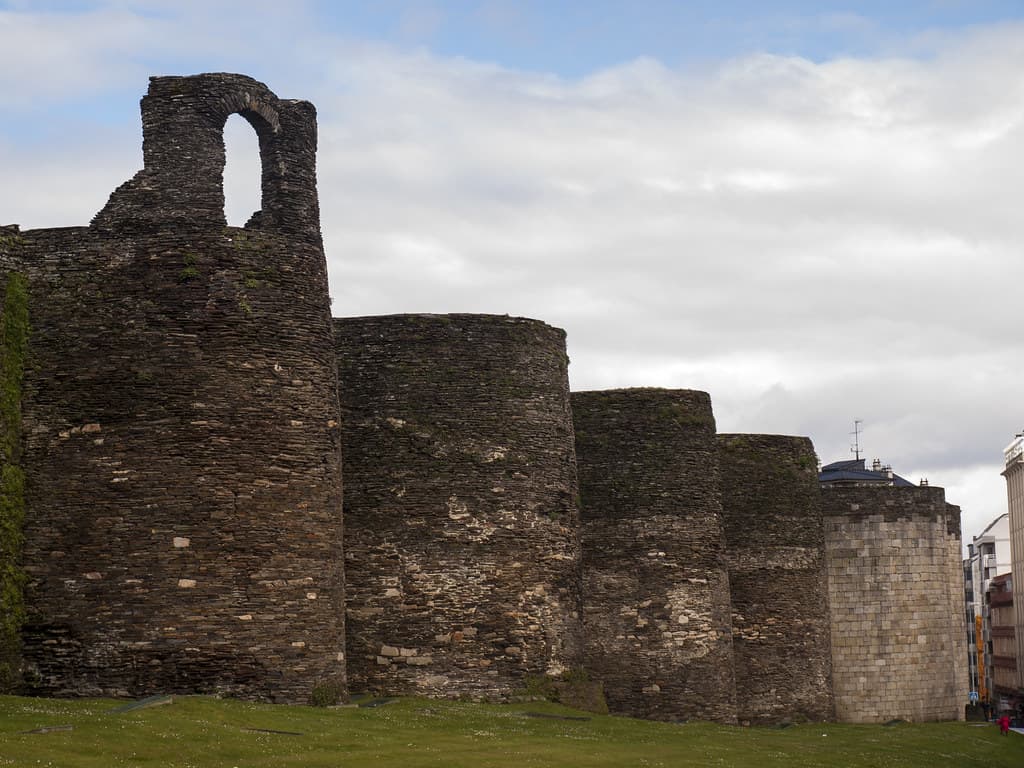
- The Roman Walls of Lugo have been a UNESCO World Heritage Site since 2000 and are part of the assets associated with the Northern Routes, although the French Way also passes through the city. This imposing fortification, built in the 3rd century, surrounds Lugo’s historic centre and is the only Roman wall in the world to have preserved its entire perimeter.
The Northern Routes of Spain: A Diverse Heritage
In 2015, UNESCO extended the recognition to include the Northern Routes of Spain, a set of paths that reflect the historical and cultural richness of the Jacobean pilgrimage along the Cantabrian coast.
These routes, which total almost 1,500 kilometres, include the Camino Primitivo, the Coastal Route, the Interior Route of the Basque Country and La Rioja, and the Lebaniego Route. In addition to the routes themselves, 16 cultural heritage sites directly linked to these routes have been included, all of which enjoy the highest level of heritage protection.
Coastal Camino (or the Northern Route)
This route runs along the Cantabrian coastline, offering spectacular landscapes and a rich cultural heritage. It is ideal for those looking for a blend of nature and history. Some of its most notable points of interest include:
- Church of Santa María de la Asunción in Castro Urdiales (Cantabria): this stunning Gothic church, built between the 13th and 15th centuries, stands majestically above the harbour. Its location and architecture make it a beacon for pilgrims walking along the coast. It is an outstanding example of Cantabrian Gothic architecture.
- Collegiate Church of Santa Juliana, in Santillana del Mar (Cantabria): considered one of the best examples of Romanesque architecture in Cantabria, this 12th-century structure is the heart of the town. Its cloister is a masterpiece of Romanesque art and a place of peace and contemplation for pilgrims. It was an important monastic centre and shelter for pilgrims.
- Cathedral of Santiago Apóstol in Bilbao (Basque Country): although Bilbao is a modern city, its old town houses this Gothic cathedral, built between the 14th and 16th centuries. It is a landmark for pilgrims.
Camino Primitivo
Regarded as the first Jacobean route, it starts in Oviedo and crosses the interior of Asturias and Galicia. It is a challenging route but one of great scenic beauty and historical richness. According to tradition, it was the route taken by King Alfonso II to visit the tomb of the Apostle James. Some of the prominent cultural sites along this route include:
- Cathedral of San Salvador and the Cámara Santa in Oviedo: this complex houses the Cámara Santa, which was independently declared a UNESCO World Heritage site. The Cámara Santa contains important relics, such as the Holy Shroud. The cathedral is the starting point of the Camino Primitivo and a place of great spiritual significance for pilgrims.
- Church and Monastery of San Salvador de Cornellana (Asturias): this monastic complex, founded in the 11th century, was an important centre for receiving pilgrims. Its Romanesque church and cloister are examples of Asturian medieval architecture.
- Church of San Salvador de Priesca, in Villaviciosa (Asturias): this small 9th-century pre-Romanesque church is a jewel of Asturian art. Its simplicity and age make it a unique testament to the origins of the Camino de Santiago. It is located on a variant of the Coastal Route that connects with the Primitivo.
Interior Route of the Basque Country and La Rioja
This route offers a more intimate and rural experience, crossing landscapes of vineyards and charming villages. Although no specific cultural sites are listed by UNESCO for this section, the route itself and the architectural elements you will see are part of the outstanding universal value of the Camino de Santiago.
Lebaniego Route
It starts in San Vicente de la Barquera and heads towards the Monastery of Santo Toribio de Liébana, connecting with the Northern Camino. The monastery, which houses the Lignum Crucis (the largest piece of the cross of Christ), is an important pilgrimage centre. This route, although shorter, is of great religious and cultural significance.
- Monastery of Santo Toribio de Liébana (Cantabria): this Franciscan monastery, founded in the 6th century, is one of the five holy places of Christianity, alongside Jerusalem, Rome, Santiago de Compostela, and Caravaca de la Cruz. Its Gothic church and cloister are of great artistic interest.
Other Caminos and Their Link to UNESCO Heritage
While the routes presented are those explicitly declared as UNESCO World Heritage sites in Spain, the Jacobean phenomenon transcends these routes.
Other options, such as the Portuguese Camino or the English Camino, although not fully included in the list, pass through or end in Santiago de Compostela, whose Old Town has been UNESCO World Heritage since 1985. This means that, regardless of the route chosen, the pilgrim will reach a destination recognised for its exceptional universal value.
The Portuguese Camino: History and Arrival in Santiago
Although its route in Portugal is not included in the UNESCO list, upon crossing the border and entering Galicia, it connects with the history and heritage associated with Santiago de Compostela.
Towns like Tui, with its impressive fortress cathedral, mark the entry into Galician territory and the influence of Jacobean heritage. ThePortuguese Camino from Tui offers a rich cultural and scenic experience, culminating in the majestic Santiago de Compostela.
Santiago de Compostela: The World Heritage City
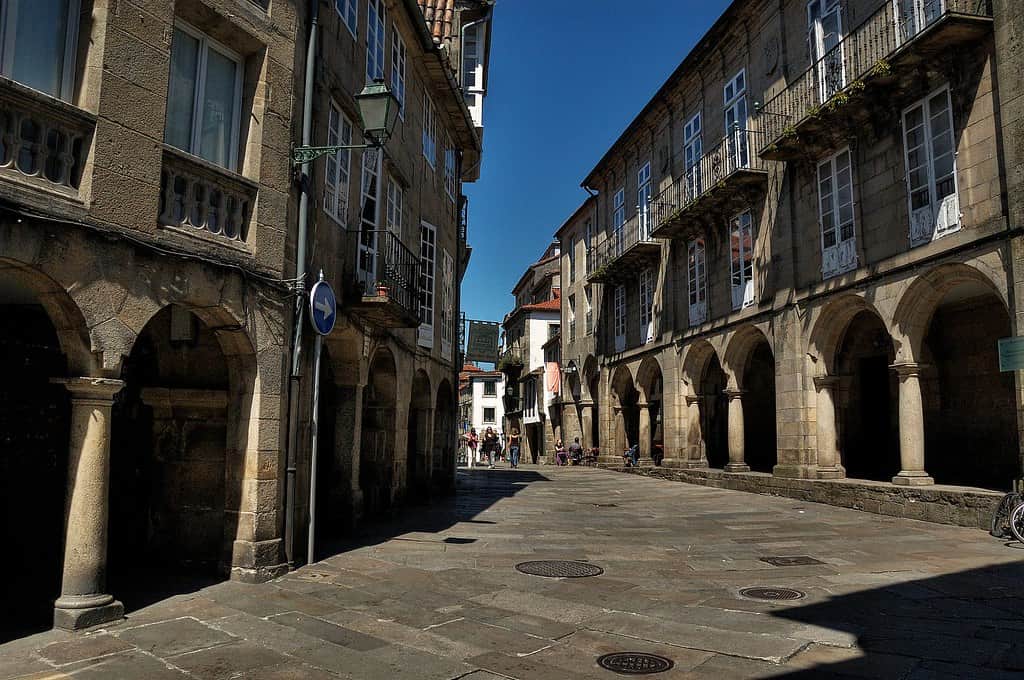
The Old Town of Santiago de Compostela was declared a World Heritage site in 1985, long before the routes themselves were included. This distinction recognises the urban beauty of the city, its historical integrity, and its significance as a pilgrimage centre.
The Cathedral of Santiago is the epicentre of this heritage, but the city as a whole is an architectural and cultural treasure. Its squares, streets, churches, convents, and palaces are witnesses to centuries of history and devotion.
The Importance of UNESCO Heritage for the Pilgrim
For the pilgrim, UNESCO World Heritage status is not just a quality mark or a tourist recognition. It means that the places they pass through have an exceptional value for all of humanity, a legacy that must be preserved and respected.
UNESCO heritage is not just about buildings or landscapes; it is the remains of a living tradition, the materialisation of the faith and culture that have shaped European identity. As they walk the Camino, pilgrims become part of this history. Each Romanesque church, each medieval bridge, each century-old hostel tells a story of effort, faith, and community.
UNESCO, by recognising these sites, reminds us of the importance of protecting this heritage for future generations of pilgrims and for the whole world. It is an invitation to walk with awareness, to observe with respect, and to appreciate the richness that surrounds us at every stage.
ASantiago de Compostela agency can help organise your pilgrimage, allowing you to focus on the experience of walking and discovering these treasures. Whether you choose theCamino del Norte from Ribadeo or theCamino de Santiago from Bilbao, you will encounter a heritage that will enrich your soul and connect you with centuries of history and spirituality.
The Camino as a European Cultural Itinerary: A Melting Pot of Exchange
The declaration of the Camino de Santiago as a UNESCO World Heritage site under criteria (II), (IV), and (VI) highlights its fundamental role as a cultural itinerary of universal importance.
- The (II) criterion recognises that it attests to a significant exchange of human values over a specific period or in a particular cultural area, in the fields of architecture, technology, monumental arts, urban planning, or landscape creation.
Since the Middle Ages, it has been a two-way route through which not only pilgrims have travelled but also ideas, artistic styles, technical knowledge, and traditions. This constant interaction between people from different geographical and cultural backgrounds has left a deep mark on the tangible and intangible heritage of the Jacobean regions.
Romanesque art, for example, spread across the Iberian Peninsula largely thanks to the Camino de Santiago. The churches, monasteries, and cathedrals built to host pilgrims along the route incorporated architectural and sculptural elements brought from other parts of Europe, creating a distinctive style.
- The (IV) criterion highlights that the Camino is an eminently representative example of a type of construction or architectural or technological ensemble, or landscape that illustrates one or more significant periods in human history.
Medieval bridges, pilgrim hospitals, hostels, and churches and cathedrals are tangible testimonies of the infrastructure created to support pilgrimage. These structures, many of which are still preserved and in use, reflect the engineering, architecture, and social organisation of the time they were built.
The cultural landscape is also a key element of its exceptional universal value. The paths, forests, rivers, and mountains form a harmonious whole that has been shaped by centuries of interaction between humans and nature.
- Finally, the (VI) criterion emphasises that the Camino is directly or materially associated with living events or traditions, ideas, beliefs, or artistic and literary works of exceptional universal importance.
Pilgrimage is one of the oldest and most relevant living traditions in Europe. It has inspired countless works of art, literature, and music, and has been a driving force for ideas and beliefs that have transcended geographical and cultural boundaries.


